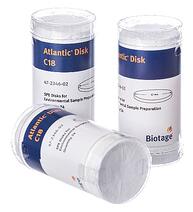Every step within a solid phase extraction (SPE) procedure is imperative, but one of the most important steps that must be done properly is the air-dry step.
As you may know, the conditioning step prepares the SPE prior to the sample load to ensure that the sample load process will capture the analytes of interest within the media bed. However, once the sample is done loading, there is a lot of water that is left on the disk. Depending on the solvents that you are using following sample load and the analytes you are capturing, an improperly dried SPE disk could ruin your day. I am going to use EPA Method 525.2 as the method example for describing the importance of the air-dry SPE step for this blog post.
Within method 525.2, there are several polar compounds that need to be extracted using the C18 disk. Just as it is important to activate the C18 disk with methanol before sample loading, it is also important to air-dry the disk for a long enough time to remove as much residual water as possible after sample loading. The polar analytes will want to stay with the water instead of sticking to the media bed, but as the water is pulled away, the media will retain the compounds within the water.
that need to be extracted using the C18 disk. Just as it is important to activate the C18 disk with methanol before sample loading, it is also important to air-dry the disk for a long enough time to remove as much residual water as possible after sample loading. The polar analytes will want to stay with the water instead of sticking to the media bed, but as the water is pulled away, the media will retain the compounds within the water.
If the air-dry step is not completed properly, it would render the methylene chloride useless in capturing these compounds from the disk due to the polarity differences between methylene chloride and water. If there is too much water left on the disk, the methylene chloride will not be able to pass through the disk and retain the compounds off the media bed even after the initial ethyl acetate elution. If the disk is dried efficiently, the ethyl acetate will be able to remove any of the remaining residual water from the disk during that first elution. Then, when the methylene chloride comes along, it can effectively do its job of retaining the compounds off the disk and bringing them to the collection vessel.
Another reason for ensuring the air-dry step is done correctly is to dry the extracts. The more residual water that is present within the extracts, more sodium sulfate is required for drying. If too much sodium sulfate is used, you can risk losing some compounds in the sodium sulfate. It is essential that the proper solvent rinsing amount is exercised to prevent analyte loss in proportion of sodium sulfate used.
Lastly, the GC-MS does not like water, so if there is any residual water in the extract because the air-dry step was not done properly or if not enough sodium sulfate was used, the GC-MS will not perform well and maintenance will be required to remove the water that reached the column before proceeding with any more testing.
As you can see, this little step should not be skipped or ‘cheated’ out on because air-drying SPE disks is like preventative maintenance; you can risk not doing it properly or at all and reap the consequences or you can make sure it is done right the first time and avoid the headache of having to re-extract samples or re-analyze extracts. For more information, read our blog post on 7 horrible mistakes you're making with SPE!

 Organic Workflow
Organic Workflow Peptide Workflow
Peptide Workflow Scale-Up Flash Purification
Scale-Up Flash Purification  Sample Preparation
Sample Preparation Biomolecule Purification
Biomolecule Purification Oligo synthesis
Oligo synthesis Scavengers and Reagents
Scavengers and Reagents Service & Support
Service & Support Accessories & Spare parts
Accessories & Spare parts Investors
Investors Reports & News
Reports & News The Share
The Share Corporate Governance
Corporate Governance Calendar
Calendar Sustainability
Sustainability Our Offering
Our Offering Our History
Our History Our Locations
Our Locations Leadership
Leadership